Every day we walk into the gym with the goal of making improvements. Shoulders are too small, back isn't thick enough, hams need more size ...
Sound familiar? Of course it does and that's why we keep going back for more. You might find some relief in knowing that the IFBB pros you admire are no different. One guy in particular who is just like you and me is Fouad Abiad, who grabbed third in the supercompetitive FLEX Pro contest earlier this year. We spoke to him after the contest and asked about his great conditioning, symmetry and much improved legs. "This was a great showing," Abiad said, "but if I'm going to make a name for myself at the Olympia, I've got to improve my arms!"
That's the beauty of what we do: no matter if you are an IFBB pro or just setting foot in a gym for the first time, you always have room for improvement. The key is to keep setting short-term goals so you are always making steps in the right direction. Abiad's short-term goal is to do everything in his power to force his bi's and tri's to grow. He has constructed a plan, analyzed his past and made damn sure to not repeat past mistakes. The result: Abiad's Seven Arm Commandments.
Fouad Abiad's Stats
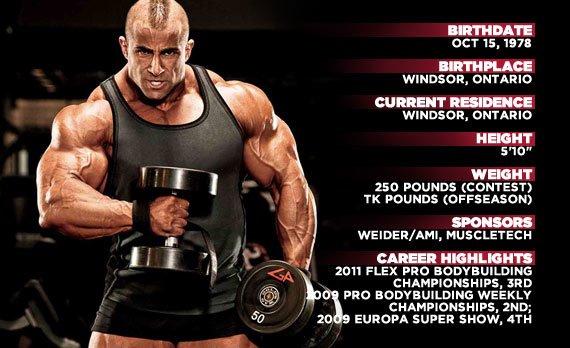
7 Arm Commandments
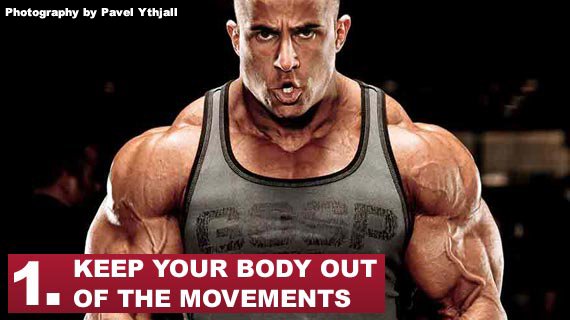
I have what's called a torso-dominant physique, which means my back and chest are dramatically stronger than my arms. This can make it really hard to isolate my arms while I train. For example, exercises such as close-grip benches are almost out of the question because the chest will bear more of the load and the triceps won't get the work they need to grow.
I focus on movements that allow for more isolation. Instead of a close-grip bench press, I'll do extensions. Instead of standing dumbbell curls, I'll do seated curls taking my body out of the movement and making my biceps do all of the work.
I see some guys leaning into each side of a standing dumbbell curl, basically making their shoulders do all the work. Barbell curls are usually done with way too much momentum, swinging the body back and forth. A little bit of momentum is OK at the end of a set, but too much and your arms aren't working hard enough. You can stop that by doing the movement seated or in some other position that locks your body in place.
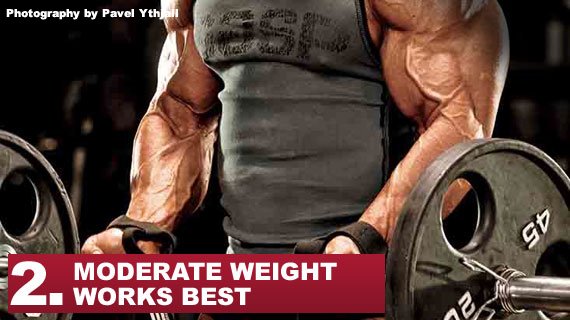
I have trained and spoken to a lot of other bodybuilders who have bad elbows or bicep tendon pain. This usually comes from trying to apply the same principles of heavy training to your biceps as you do to your back or legs. The biceps is a small muscle without too many active parts, so why would you train it the same way you train your larger bodyparts that are made up of several different muscles?
I decided that the biceps and triceps need to be hit from numerous angles but not with the same weight and rep scheme used for larger bodyparts. So the answer was to lighten up and use different intensity techniques like drop sets, rest pause and forced reps. And I never go lower than 8 reps and more often than not, I'm in the 10-12 range.
When I get a few nagging injuries, I go really high with the reps (15-20) and lighten up the weight for a couple of weeks until I'm healed. If I stick with the higher reps for a longer period, my arms look like noodles. Going too light gave me a lactic acid burn and still gave me a pump, but it didn't last and after a few weeks I really felt like my arms were shrinking. The goal is to find the middle spot where you are really giving it your all, but you're not doing sets of 4 or 6.
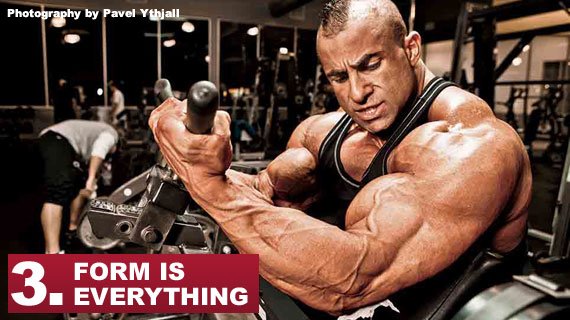
I'm sure you've heard this saying before, but it's the truth: you have to control the weight, don't let it control you. Standing dumbbell curls, standing barbell curls and triceps pressdowns immediately come to mind as exercises done with loose form.
I make a conscious effort to keep my back straight if I'm doing any of the exercises mentioned above. If I want to go heavy I'll do the movements seated, lying, on a preacher or any other way to make sure I'm performing it the way it was intended.
One of the best methods is to just make sure you have a good partner who won't bullsh!t you. If I believe I'm getting sloppy, I can always just ask them, "Hey, was that set garbage or is my form OK?" Once I get the answer, I know what to adjust. Even if you don't have a solid training partner, go into the gym with a mental picture of your ideal form and, during each set, hold yourself responsible for achieving that ideal.
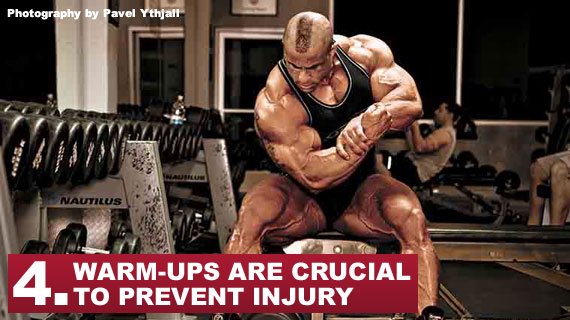
Not warming up properly can destroy tendons or tear muscles. Aside from those huge concerns, not taking the time to warm-up makes it harder to get the proper mindset. Every workout is an opportunity to spur new growth so you need 100% focus and warming up and feeling your muscles work helps me achieve that.
When I get to the gym, the first thing I usually do is get on a bike or a treadmill, and I make sure I get in a good 5-10 minutes of brisk cardio to get some blood flowing. The first exercise of my biceps or triceps workout is usually preceded by three warm-up sets. For example, if I start with seated dumbbell curls, I'll begin with 20-pound weights and work up to 30s and 40s, and then I begin my working sets - 50s, 60s, 70s (if I ate my Wheaties that day).
I usually pyramid all my exercises so I always start a little lighter in a 12-rep range and then go to 8 or 10 reps. Essentially, all of the first working sets are an extension of the warm-up, because it's getting me ready for the heavier 8-rep sets coming next.
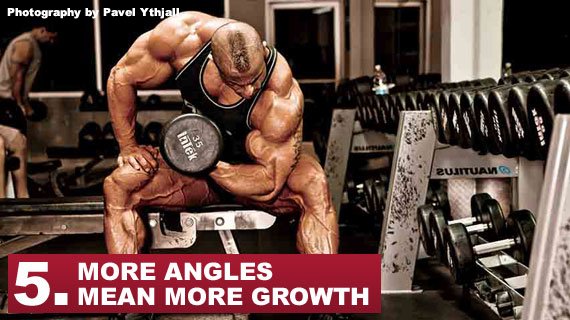
Being one-dimensional with your exercises limits your development. The three muscles that make up your triceps and the two that make up your biceps need different angles to all be stimulated properly and give you the best overall growth.
You can hit the triceps from the front with a pressdown, from the back with an extension and as a whole with a dip. You can work the biceps inner head with a concentration curl or the outer head with a hammer curl. You can't have great arms if your triceps look great from the front but not the back.
Here are some more examples of how I utilize the various angles:
- Hammer curls can be done across the body or to the side. When I do them across the body, I feel more of the biceps and less of the brachialis.
- Concentration curls can be done sitting down with your elbow on your knee or leaning on the weight rack with your arm hanging down. When I do them against my inner knee, I feel it more on the inner biceps as opposed to when I lean on the weight rack. I can feel more of the entire biceps or even a little more on the outer head.
- Extensions can be done on a flat bench, seated, incline or decline. I feel the biggest stretch in the long head of my triceps when doing them on a decline.
- Overhead cable extensions can be done by separating the ropes as you extend your arms and really squeezing the triceps; or you can do them with your elbows tucked in next to your head and your hands close together. To make sure I'm not missing anything I will often start the exercise the first way and when I think I'm done, I will switch and get 5 or so more reps!
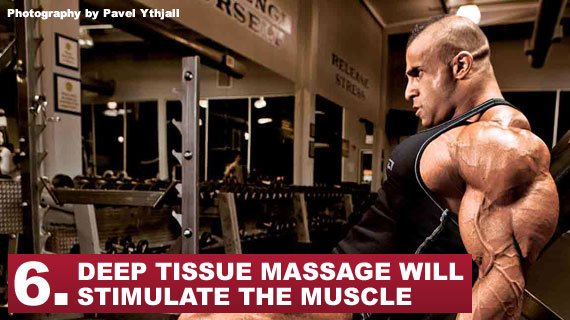
A muscle is surrounded by a fascia, or a "sack" that holds it together. When that fascia is tight, it restricts the amount of area there is for your muscle to grow. Deep tissue massage is a great way to loosen and stretch out that fascia, allowing for more room for muscle growth. Also, deep tissue massage will flush the area of any scar tissue allowing for more blood flow or pump when you're training.
If you have injuries, I recommend two treatments per week until you're healed. If you're doing it just to stay healthy, allow for better workouts and growth, once a week is good enough.
If you don't know of a good therapist who understands bodybuilders, then ask around at your gym. If all the bodybuilders in the area are seeing one guy or girl there is usually a good reason. When I was trying to find someone reliable, I went to see a female masseuse - no word of mouth, I just picked her out of the phone book.
She said she knew how to push hard enough to really break things up. So I went with it and 10 minutes into the massage I was asleep. Needless to say that was my last time there. If your massage is relaxing you or making you happy, it's the wrong kind of massage. When I leave the doctor's office I feel like I got my ass kicked and I need to sleep just to recover.
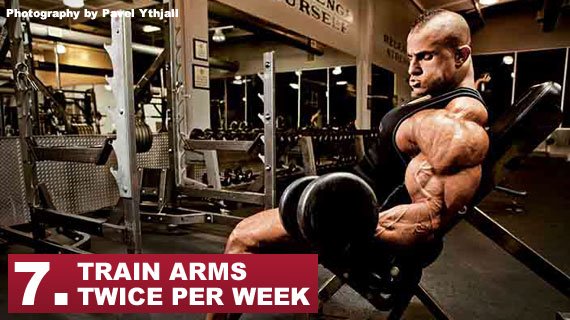
A lot of people tend to follow a training split just because it's what everybody does or because it's printed in a book. And once they find a split they like, they never change it. My split has changed a lot over the years because of my ever-changing body and what I think it needs to become elite in the IFBB. You have to tailor your program to suit your specific needs.
My current split lets me focus on the things I need most: arms, calves and hamstrings. The second arms workouts (see split and training charts) are quick and not intense enough to cause overtraining, but they're important to help keep blood flow in the area. Hany [Rambod, Abiad's trainer] and I both feel that the more you can keep a muscle pumped, the more you're going to stretch that fascia and cause more growth.
Don't be worried that you're going to overtrain by hitting a muscle group twice in one week. Biceps and triceps recover fast since they are smaller muscles, so I know I'm training them just enough, but not too much, to keep them growing.
Abiad's Arms Workouts


Pressdowns
5 pyramid sets of 15-8 reps

Seated Overhead Extensions
4 sets of 10-12 reps

Machine Dips
4 sets of 8-10 reps

Reverse-Grip One-Arm Pressdowns
3 sets of 15 reps

Seated Incline Dumbbell Curls
5 pyramid sets of 15-6 reps

Hammer Preacher Curls
4 sets of 10 reps

Barbell Curls
4 sets of 8-10 reps
Biceps (After Back)


Seated Dumbbell Curl
4 sets of 8-10 reps

Lying Cable Curls
4 sets of 8-10 reps
Triceps (After Chest)


Pressdowns
4 sets of 12 reps

Dumbbell Kickbacks
4 sets of 10 reps
- Sunday: Off
- Monday: Quads and hams
- Tuesday: Arms and calves
- Wednesday: Off
- Thursday: Back and bi's
- Friday: Chest and tri's
- Saturday: Shoulders
Photo Shoot Location: Gold's Gym Hawthorne; Hawthorne, California
Interview by Sean Andros
Photography by Pavel Ythjall

